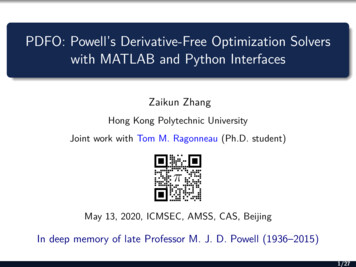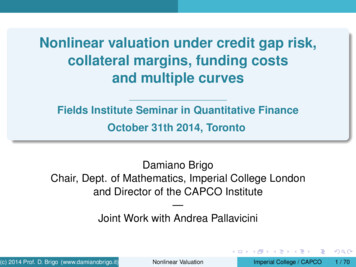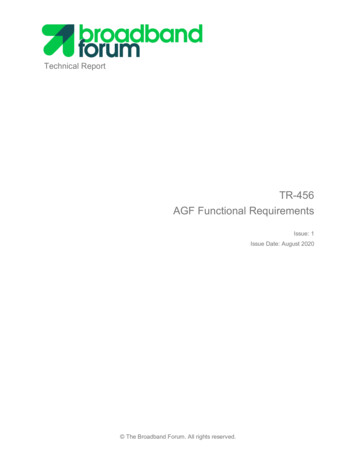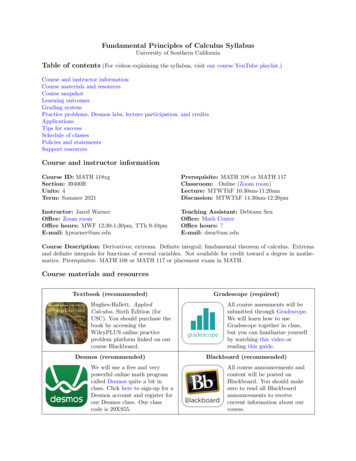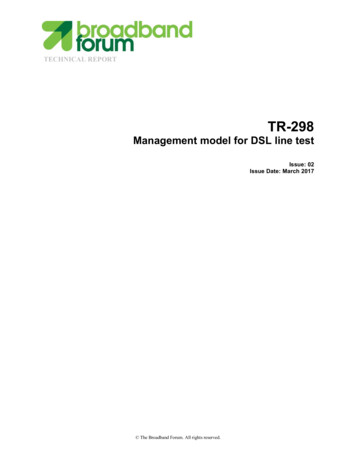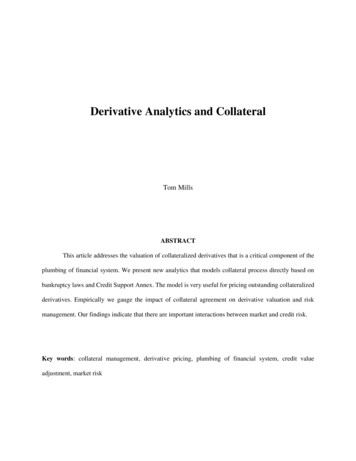
Transcription
Derivative Analytics and CollateralTom MillsABSTRACTThis article addresses the valuation of collateralized derivatives that is a critical component of theplumbing of financial system. We present new analytics that models collateral process directly based onbankruptcy laws and Credit Support Annex. The model is very useful for pricing outstanding collateralizedderivatives. Empirically we gauge the impact of collateral agreement on derivative valuation and riskmanagement. Our findings indicate that there are important interactions between market and credit risk.Key words: collateral management, derivative pricing, plumbing of financial system, credit valueadjustment, market risk
Collateral arrangements are regulated by the Credit Support Annex (CSA) and is a critical component ofthe plumbing of financial system. The use of collateral in financial markets has increased sharply over thepast decade, yet the effect of collateralization on valuation and risk is an understudied area.We present a model that characterizes a collateral process directly based on the fundamentalprincipal and legal structure of CSA. The model is devised that allows for collateralization adhering tobankruptcy laws. As such, it can back out price changes due to counterparty risk and collateral posting. Ourmodel is very useful for valuing off-the-run or outstanding derivatives.This article uses an indirect empirical approach. We define a swap premium spread as the premiumdifference between two swap contracts that have exactly the same terms and conditions but are traded withdifferent CSA counterparties. We reasonably believe that if two contracts are identical except counterparties,the swap premium spread should reflect counterparty credit risk only, as all other risks/costs are identical.Interest rate swaps collectively account for two-thirds of all outstanding derivatives. An ISDA midmarket swap rate is based on a mid-day polling. Dealers use this market rate as a reference and make someadjustments to quote an actual swap rate. The adjustment or swap premium is determined by many factors,such as credit risk, liquidity risk, funding cost, operational cost and expected profit, etc.Unlike generic mid-market swap rates, swap premia are determined in a competitive marketaccording to the basic principles of supply and demand. A swap client first contacts a number of swapdealers for a quotation and then chooses the most competitive one. If a premium is too low, the dealer maylose money. If a premium is too high, the dealer may lose the competitive advantage.Empirically, we obtain a unique proprietary dataset from an investment bank. We use these dataand a statistical measurementR2to examine whether credit risk and collateralization, alone or incombination, are sufficient to explain market swap premium spreads. The estimation result shows that theadjustedR2is 0.7472, implying that approximately 75% of market spreads can be explained bycounterparty credit risk. In other words, counterparty risk alone can provide a good but not overwhelmingprediction on spreads.1
We then assess the joint effect. Because implied or model-generated spreads take into account bothcounterparty risk and collateralization, we assign the model-implied spreads as the explanatory variableand the market spreads as the response variable. The new adjustedR2is 0.9906, suggesting thatcounterparty risk and collateralization together have high explanatory power on premium spreads. Thefinding leads to practical implications, such as collateralization modeling allows forecasting credit spread.Second, we select all the CSA counterparty portfolios in the dataset and then compute their CVAs.We find that the CVA of a collateralized counterparty portfolio is always smaller than the one of the sameportfolio without collateralization. We also find that credit risk is negatively correlated withcollateralization as an increase in collateralization causes a decrease in credit risk. The empirical testscorroborate our theoretical conclusions that collateralization can reduce CVA charges and mitigatecounterparty risk.The rest of this article is organized as follows: First we present a new model for pricingcollateralized financial derivatives. Then we discuss empirical evidences. Finally, the conclusions anddiscussion are provided. All proofs and detailed derivations are contained in the appendices.Pricing Collateralized DerivativesWe consider a filtered probability space ( , F , Ft t 0 , P ) satisfying the usual conditions,where denotes a sample space, F denotes a -algebra, P denotes a probability measure, and Ft t 0denotes a filtration. In the reduced-form framework, the stopping or default time of a firm is modeledas a Cox arrival process whose first jump occurs at default and is defined by, t inf t : h(s, s )ds where0(1)h(t ) or h(t , t ) denotes the stochastic hazard rate dependent on an exogenous common state t , and is a unit exponential random variable independent of t .It is well-known that the survival probability from time t to s in this framework is defined by2
sp(t , s) : P( s t ) exp h(u )du t (2a)The default probability for the period (t, s) is given bysq(t , s) : P( s t ) 1 p(t , s) 1 exp h(u )du t (2b)Let valuation date be t. Consider a financial contract that promises to pay a X T 0 at maturitydate T t , and nothing before the time.The binomial default rule considers only two possible states: default or survival. For a discrete onepayment period (t, T ) economy, at time T the contract either defaults with the default probabilityor survives with the survival probabilityq(t ,T )p (t , T ) . The survival payoff is equal to X T and the default payoffis a fraction of X T : X T , where is the recovery rate. The value of this defaultable contract at time t isthe discounted expectation of all the possible payoffs and is given byV N (t ) E D(t , T ) p(t , T ) (T )q(t , T ) X T Ft E D(t , T ) I (t , T ) X T Ft (3)where E F t is the expectation conditional on Ft , D(t , T ) denotes the risk-free discount factor at timet for maturity T and I (t , T ) p(t , T ) (T )q(t , T ) can be regarded as a risk-adjusted discount ratio.Suppose that there is a CSA agreement between a bank and a counterparty in which the counterpartyis required to deliver collateral when the mark-to-market (MTM) value arises over the effective thresholdH.The default payment under a CSA can be mathematically expressed asP D (T ) C (T ) (T )( X T C (T ) ) (T ) X T C (T )(1 (T ))where(4)C (T ) is the collateral amount at T.CAccording to CSA, if the contract value V (t ) is less than the effective thresholdH (t ), nocollateral is posted; otherwise, the required collateral is equal to the difference between the contract valueand the effective threshold. The collateral amount posted at time t can be expressed mathematically as3
C (t ) max( V C (t ) H (t ), 0)whereH (t ) 0H (t ) 0(5)corresponds to full-collateralization; H (t ) 0 represents partial-collateralization; andreflects over-collateralization.The value of the CSA contract is the discounted expectation of all the payoffs and is given byV C (t ) E D(t , T ) q(t , T )(C (T ) (T )( X T C (T ))) p(t , T ) X T Ft (6)After some simple mathematics, we have the following propositionProposition 1: The value of a collateralized single-payment contract is given by (7a))(7b)V C (t ) E F (t , T ) X T Ft G (t , T )where(F (t, T ) 1V N (t ) H (t ) 1V N (t ) H (t ) / I (t, T ) I (t, T ) D(t, T )G(t, T ) 1V N (t ) H (t ) H (t )q (t, T )(1 (T )) / I (t, T )(7c)where I (t , T ) E (I (t , T ) Ft ) . I (t , T ) and V N (t ) are defined in (3).Proof: See the Appendix.The pricing in Proposition 1 is relatively straightforward. We first compute V N (t ) and then testwhether its value is greater than H (t ) . After that, the calculations of F (t , T ) , G(t , T ) and V C (t ) are easilyobtained.We discuss a special case where H (t ) 0 corresponding to full-collateralization. Suppose thatdefault probabilities are uncorrelated with interest rates and payoffs1. From Proposition 1, we can easily1Moody’s Investor’s Service [2000] presents statistics that suggest that the correlations between interestrates, default probabilities and recovery rates are very small and provides a reasonable comfort level for theuncorrelated assumption.4
obtain V C (t ) V F (t ) where V F (t ) E D(t , T ) X T Ft is the risk-free value. That is to say: the value of afully-collateralized contract is equal to the risk-free value.Proposition 1 can be easily extended from single payment to multiple payments. Suppose that adefaultable contract has m cash flows represented as X i with payment dates Ti , where i 1, ,m. Wederive the following proposition:Proposition 2: The value of a collateralized multiple-payment contract is given by i 1() m 1 i 1()V C (t ) i 1 E j 0 F (T j , T j 1 ) X i Ft i 0 E j 0 F (T j , T j 1 ) G(Ti , Ti 1 ) Ftm (8a)where()F (T j , T j 1 ) 1J (T j ,T j 1 ) H (T j ) 1J (T j ,T j 1 ) H (T j ) / I (T j , T j 1 ) I (T j , T j 1 )D(T j , T j 1 )()G(T j , T j 1 ) 1J (T j ,Tj 1 ) H (Tj ) H (T j )q (T j , T j 1 ) 1 (T j 1 ) / I (T j , T j 1 )()J (T j , T j 1 ) E D(T j , T j 1 ) I (T j , T j 1 ) V C (T j 1 ) X j 1 FT j where i 1j 0(8b)(8c)(8d)F (T j , T j 1 ) 1 is an empty product when i 0 . Empty product allows for a much shortermathematical presentation of many subjects.The valuation in Proposition 2 has a backward nature. The most popular backward inductionalgorithms are lattice/tree and regression-based Monte Carlo.Empirical ResultsIn this subsection, we study how collateralization affects credit risk by measuring CVA changesdue to collateral posting. CVA is the market price of counterparty credit risk that has become a central partof counterparty credit risk management.We find that there are a total of 3052 counterparties having live trades as of May 11, 2012. 516 ofthem have CSA agreements. We randomly select one counterparty portfolio that contains 476 interest rateswaps, 36 interest rate swaptions and 223 interest rate caps/floors. First, we compute the risk-free value5
V F 2,737 ,702 that is relatively straightforward as the risk-free portfolio value is what trading systemsor pricing models normally report.We assume that there is counterparty credit risk but no collateral agreement. Based on the pricingmodel proposed by Xiao [2015], we compute the risky value of the portfolio as V N 2,688 ,014 afterconsidering counterparty credit risk. By definition, the CVA without collateralization is equal toCVAN V F V N 49,688.Next, we further assume that there is a CSA agreement in which the threshold is 2 million and theMTA is 100,000. The risky value of the portfolio is calculated as V C 2,725 ,094 according toProposition 2. The CVA with collateralization is given by CVAC V F V C 12,608 . Similarly, we cancompute the CVAs under different collateral arrangements and present the results in Exhibit 9.Exhibit 9. Impact of Collateralization on CVAThis exhibit shows that CVA increases with collateral threshold. The infinite collateral threshold isequivalent to no collateral agreement and the zero-value collateral threshold corresponds to fullcollateralization. An increase in collateral threshold leads to a decrease in collateralization.Effective Threshold02.1 Million4.1 Million6.1 Million8.1 MilInfinite ( )CVA012,60823,68533,50442,25449,688Exhibit 9 tells us that collateral posting can reduce CVA. Full collateralization makes a portfolioappear to be risk-free. An increase in collateral threshold leads to a rise in unsecured credit exposure, andthereby an increase in CVA. In particular, CVA reaches the maximum when the threshold is infiniterepresenting no collateral arrangement.We extend our analysis to other CSA portfolios. The results hold across different CSAcounterparties and collateral agreements. Our findings show that collateral posting can reduce credit riskand CVA. The results also suggest a negative correlation between collateralization and CVA as an increase6
in collateralization causes a decrease in CVA charge and vice-versa. These findings improve ourunderstanding of the relationship between collateralization and CVA.ConclusionThis article presents a new model for pricing collateralized financial contracts based on thefundamental principal and legal structure of CSA. The model can back out market prices. This is very usefulfor pricing outstanding collateralized derivatives.Empirically, we use a unique proprietary dataset to measure the effect of collateralization on pricingand compare it with model-implied prices. The empirical results show that the model-implied prices arequite close to the market-quoted prices, suggesting that the model is fairly accurate on pricing collateralizedderivatives.We find strong evidence that counterparty credit risk alone plays a significant but notoverwhelming role in determining credit-related spreads. Only the joint effect of collateralization and creditrisk has high explanatory power on unsecured credit costs. This finding suggests that failure to properlyaccount for collateralization may result in significant mispricing of derivatives.We also find evidence that there is a strong linkage between market and credit risk. Our researchresults suggest that banks and regulators need to think about an integrated framework to capture materialinteractions of these two types of risk. This requires all profits and losses are gauged in a consistent wayacross risk types as they tend to be driven by the same economic factors.AppendixProof of Proposition 1: The binomial default rule considers only two possible states: default orsurvival. For a discrete one-payment period (t , T ) economy, at time T, the contract either defaults with thedefault probability q(t , T ) or survives with the survival probability p (t , T ) . The survival value is the7
promised payoff X T and the default payment is C (T ) (T )( X T C (T )) . The value of this collateralizedcontract is the discounted expectation of all the payoffs and is given byV C (t ) E D(t , T ) q(t , T )(C (T ) (T )( X T C (T ))) p(t , T ) X T Ft (A1)The collateral posted at time t is defined in (5). The value of the collateral at time T becomesC (T ) C (t ) / D(t , T ) , where we consider the time value of money only for collateral assets.If V C (t ) H (t ) , we have C (t ) V C (t ) H (t ) andV C (t ) V N (t ) / I (t , T ) H (t )q (t , T )(1 (T ) ) / I (t , T )(A2)where I (t , T ) D(t , T ) p(t , T ) (T )q(t , T ) , I (t , T ) E (I (t , T ) Ft ) , and V N (t ) E I (t , T ) X T Ft .In this case, V C (t ) H (t ) is equivalent to V N (t ) H (t ) .If V C (t ) H (t ) , we have C (t ) 0 andV C (t ) V N (t ) H (t )(A3)Combining the two cases of V C (t ) H (t ) and V C (t ) H (t ) , we get V C (t ) 1V N (t ) H (t ) V N (t ) 1V N (t ) H (t ) V N (t ) / I (t, T ) H (t )q (t, T )(1 (T )) / I (t, T ) (A4)or V C (t ) E F (t , T ) X T Ft G (t , T )(A5a)F (t, T ) 1V N (t ) H (t ) 1V N (t ) H (t ) / I (t, T ) I (t, T )D(t, T )((A5b)G(t, T ) 1V N (t ) H (t ) H (t )q (t, T )(1 (T )) / I (t, T )(A5c)where)Proof of Proposition 2: Let t T0 . On the first payment dayT1 , let V C (T1 ) denote the CSA valueof the contract excluding the current cash flow X 1 . According to Proposition 1, the CSA value of thecontract at t is given by () V C (t ) E F (T0 , T1 ) X 1 V C (T1 ) Ft G (T0 , T1 )(A6)8
Similarly, we have ( )V C (T1 ) E F (T1 , T2 ) X 2 V C (T2 ) F T1 G(T1 , T2 )(A7)Note that F (T0 , T1 ) and G(T0 , T1 ) are F T 1 -measurable. According to the taking out what isknown and tower properties of conditional expectation, we have ( )V C (t ) E F (T0 , T1 ) X 1 V C (T1 ) Ft G (T0 , T1 ) 2Ei 1 i 01 (F (T , T )) X F E (F (T , TE (F (T , T ) )G (T , T ) F i 1j 0i 1j 0j 1jj 1j1j 0tiijj 1 ))V C (T2 ) Ft (A8)ti 1CBy recursively deriving from T2 forward over Tm , where V (Tm ) X m , we obtain i 1( )m 1 i 1()V C (t ) i 1 E j 0 F (T j , T j 1 ) X i Ft i 0 E j 0 F (T j , T j 1 ) G(Ti , Ti 1 ) Ftmwhere i 1j 0 (A9)F (T j , T j 1 ) 1 is an empty product when i 0 .ReferencesBCBS. “Findings on the interaction of market and credit risk.” Working paper No. 16, (2009).Collin-Dufresne, P. and Solnik, B. “On the term structure of default premia in the swap and LIBOR markets.”Journal of Finance 56 (2001), pp.1095-1115.Duffie, D., and K.J. Singleton, K.J. “Modeling term structure of defaultable bonds.” Review of FinancialStudies, 12(1999), pp. 687-720.Edwards, F. and Morrison, E. “Derivatives and the bankruptcy code: why the special treatment?” YaleJournal on Regulation, 22 (2005), pp. 101-133.Feldhutter, P. and Lando, D. “Decomposing swap spreads. Journal of Financial Economics,” 88 (2008), pp.375-405.FinPricing, 2017, Market Data, https://finpricing.com/lib/EqBarrier.html9
Garlson, D. “Secured creditors and the eely character of bankruptcy valuations.” 41 American UniversityLaw Review, 63 (1991-1992), pp. 63-106.Grinblatt, M., “An analytic solution for interest rate swap spreads.” Review of International Finance, 2(2001), pp. 113-149.Johannes, M. and Sundaresan, S. “The impact of collateralization on swap rates.” Journal of Finance, 62(2007), pp. 383-410.J.P. Morgan, “Par credit default swap spread approximation from default probabilities.” 2001.Liu, J., Longstaff, F. and Mandell, R. “The Market Price of Risk in Interest Rate Swaps: The Roles ofDefault and Liquidity Risks,” The Journal of Business, 79 (2006), pp. 2337-2360.Minton, B. “An Empirical Examination of Basic Valuation Models for Plain Vanilla U.S. Interest RateSwaps.” Journal of Financial Economics, 44 (1997), pp. 251-277.Moody’s Investor’s Service. “Historical default rates of corporate bond issuers, 1920-99.” 2000Piterbarg, V. “Funding beyond discounting: collateral agreements and derivatives pricing.” Risk Magazine,2010 (2010), pp. 97-102.Routh, R. and Douglas, M. “Default interest payable to oversecured creditor subject to reasonablenesslimitation.” ABF Journal, Vol. 4, No. 3 (2005), pp. 1-10.Sorensen, E. and Bollier, T. “Pricing swap default risk.” Financial Analysts Journal, 50 (1994), pp. 23-33.10
Key words: collateral management, derivative pricing, plumbing of financial system, credit value adjustment, market risk . 1 Collateral arrangements are regulated by the Credit Support Annex (CSA) and is a critical component of . CVA is the market price of counterparty credit risk that has become a central part

